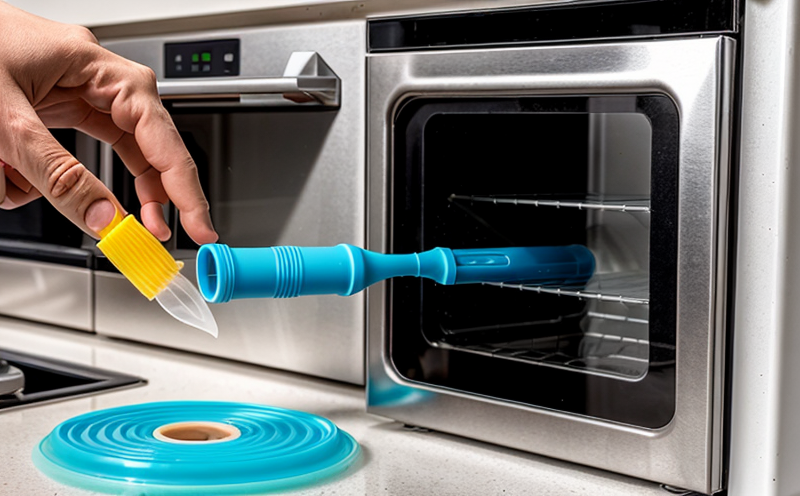ISO 604 Compression Properties Testing of Household Plastics
The ISO 604 standard provides a method for determining the compression properties of household plastics, which is crucial in ensuring product safety and performance. This test evaluates how a plastic specimen behaves under compressive forces, providing valuable insights into its mechanical integrity, durability, and suitability for various applications.
For household plastics, this testing can help identify materials that are prone to deformation or failure under typical usage conditions. For instance, a low compression modulus could indicate potential issues with the product's longevity if exposed to frequent pressure during use. The test is particularly important in sectors like home appliances, packaging, and consumer goods where material performance directly impacts user safety and satisfaction.
The testing procedure involves compressing a small specimen of the plastic under controlled conditions and measuring the resulting deformation. This data helps manufacturers make informed decisions about which materials to use, ensuring that products meet regulatory requirements while also enhancing their market competitiveness through improved quality.
Understanding the compression properties is essential for predicting how plastics will perform in real-world environments. For example, knowing a plastic’s resistance to crushing under pressure can inform design choices and material selection processes. This knowledge ensures that household goods are not only functional but also safe and reliable, contributing significantly to consumer trust and satisfaction.
The ISO 604 standard is widely recognized for its accuracy in assessing compression properties, making it an indispensable tool for industries reliant on quality plastics. By adhering to this standard, manufacturers can ensure consistent product performance across different batches and locations. This consistency not only enhances brand reputation but also streamlines supply chain management by reducing variability.
Furthermore, the test results provide a basis for comparing various materials' performance, allowing companies to innovate more effectively. For instance, if one material consistently outperforms others in terms of compression strength, it opens up opportunities for market differentiation and potentially higher profit margins.
In conclusion, ISO 604 Compression Properties Testing is a vital step in the development and quality assurance process of household plastics. It ensures that products not only meet safety standards but also perform reliably under expected conditions, thereby enhancing overall product value and customer satisfaction.
Why It Matters
Compliance with ISO 604 is crucial for ensuring the safety and performance of household plastics. Compliance not only protects consumers from potential hazards but also helps manufacturers meet regulatory requirements, thereby avoiding costly fines or recalls.
- Avoids Consumer Harm: Testing ensures that household products are safe to use, reducing the risk of accidents or injuries caused by material failure under pressure.
- Safeguards Reputation: Consistent adherence to standards can significantly enhance a brand’s reputation and consumer trust. Poor quality products can lead to negative publicity and lost market share.
- Facilitates Market Access: Meeting international standards like ISO 604 is often a prerequisite for entering global markets, opening up new opportunities for growth and expansion.
The economic benefits of compliance are also substantial. By using tested materials, manufacturers can reduce waste and improve efficiency in production processes. This leads to cost savings that can be passed on to consumers or reinvested into further research and development.
Moreover, the environmental considerations associated with ISO 604 testing cannot be overlooked. Testing helps in selecting sustainable materials that have lower impacts throughout their lifecycle, from production to disposal. This aligns with broader sustainability goals within the industry, contributing positively to environmental stewardship.
Environmental and Sustainability Contributions
The testing of household plastics according to ISO 604 contributes significantly to sustainable practices by promoting the use of environmentally friendly materials. By ensuring that plastics are robust enough for their intended applications, this test helps in minimizing waste generation and extending product lifecycles.
- Reduction in Waste: Robust household plastics last longer, reducing the need for frequent replacements and subsequent disposal.
- Eco-Friendly Materials Selection: Testing aids in identifying materials with lower environmental footprints, supporting green initiatives and corporate social responsibility (CSR) goals.
The test also encourages innovation towards more sustainable practices. Manufacturers can use the insights gained from ISO 604 testing to develop new products that are not only functional but also environmentally friendly. This aligns with global trends toward circular economy models, where materials are reused and recycled rather than discarded.
Additionally, compliance with this standard helps companies meet increasingly stringent environmental regulations across different regions. By adhering to international standards like ISO 604, manufacturers can ensure they remain competitive in a rapidly evolving market landscape characterized by heightened consumer awareness of environmental issues.
Use Cases and Application Examples
- Bathroom Accessories: Testing ensures that shower heads and faucet handles maintain their shape under water pressure, enhancing product durability and reliability.
- Cooking Utensils: Robust plastic containers and lids are essential for maintaining food safety during storage and handling.
- Toys and Games: Safe and durable materials contribute to child safety by preventing accidents from material failure.
In each of these applications, ISO 604 testing ensures that household plastics meet stringent performance criteria. This not only enhances product quality but also fosters trust among consumers who value reliability and safety in their daily lives. The test results are critical for manufacturers aiming to innovate and stay ahead in a competitive market, where differentiation is key.





